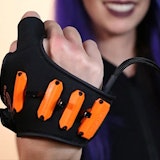By
Alex Angove
Last updated
 The Galaxy S4 Zoom will join Samsung’s new family of S4 devices, and replace the interesting, if variably popular Samsung Galaxy Camera from 2012; merging a smartphone with a digital camera with full optical lens.
The S4 Zoom looks like a much more appealing device than the Galaxy Camera right at the outset. The 15.4mm profile and weight of just 208grams is much less of a barrier than its 19.1mm thick, 300 gram predecessor.
The dual-core 1.5GHz processor running Android 4.2.2, 4.3-inch 540x960 display and MicroSD slot for expandable memory make the S4 Zoom essentially a Galaxy S4 Mini on the front with a digital camera jammed on the back.
The camera itself is a 16MP CMOS shooter. 10x optical zoom will outdo even the best digital-zoom options on the market right now. Couple that with optical image stabilization and a proper xenon, rather than LED, flash and you’ve got yourself a fine-sounding smart-camera.
As far as internal storage goes there’s only a disappointing 5GB available for the user, which won’t go very far. Luckily, as we mentioned earlier, there’s a MicroSD slot that should support up to 64GB of expandable memory.
Samsung plans to release the S4 Zoom in both 3G and 4G LTE versions, depending on region.
The Galaxy S4 Zoom will join Samsung’s new family of S4 devices, and replace the interesting, if variably popular Samsung Galaxy Camera from 2012; merging a smartphone with a digital camera with full optical lens.
The S4 Zoom looks like a much more appealing device than the Galaxy Camera right at the outset. The 15.4mm profile and weight of just 208grams is much less of a barrier than its 19.1mm thick, 300 gram predecessor.
The dual-core 1.5GHz processor running Android 4.2.2, 4.3-inch 540x960 display and MicroSD slot for expandable memory make the S4 Zoom essentially a Galaxy S4 Mini on the front with a digital camera jammed on the back.
The camera itself is a 16MP CMOS shooter. 10x optical zoom will outdo even the best digital-zoom options on the market right now. Couple that with optical image stabilization and a proper xenon, rather than LED, flash and you’ve got yourself a fine-sounding smart-camera.
As far as internal storage goes there’s only a disappointing 5GB available for the user, which won’t go very far. Luckily, as we mentioned earlier, there’s a MicroSD slot that should support up to 64GB of expandable memory.
Samsung plans to release the S4 Zoom in both 3G and 4G LTE versions, depending on region.
What’s the point?
 Smartphone cameras may be better than ever, but they still can’t compare to a real camera with a proper lens system. Especially at night or when capturing fast-moving objects, smartphone cameras are still a few generations away from providing a truly great photo experience.
You also gain the many benefits of running the Android OS in a camera. This adds access to a multitude of great photography apps for photographers, including favorites like Instagram and Snapchat.
The S4 Zoom certainly isn’t going to appeal to everyone, but someone who doesn’t mind that extra 7mm of thickness and who thinks they’ll get a lot of use out of carrying a proper camera around with them everywhere is going to want to take a look at this device.
Smartphone cameras may be better than ever, but they still can’t compare to a real camera with a proper lens system. Especially at night or when capturing fast-moving objects, smartphone cameras are still a few generations away from providing a truly great photo experience.
You also gain the many benefits of running the Android OS in a camera. This adds access to a multitude of great photography apps for photographers, including favorites like Instagram and Snapchat.
The S4 Zoom certainly isn’t going to appeal to everyone, but someone who doesn’t mind that extra 7mm of thickness and who thinks they’ll get a lot of use out of carrying a proper camera around with them everywhere is going to want to take a look at this device.
Issues
Obviously the thickness is a major issue. Most people aren’t going to be too happy with the prospect of carrying around a 1.5cm thick device everywhere. The biggest problem is going to be actual image quality. It became apparent after the Samsung Galaxy was originally released that, in many situations, it was equal to or even worse that the GS3, Lumia 920 and iPhone 5 at image capture. If Samsung’s going to make such a bulky device worth owning it’s going to have to provide a significantly superior camera than what the flagship smartphones of this year could hope to offer.Competition with Nokia PureView 41MP camera
With Nokia gearing a lot of its marketing at phone photography, some might say Samsung has ‘scooped’ the Finnish giant with this announcement. Not so. The 41MP PureView camera that our own Joe Hanlon recently explained would be a very different device to the S4 Zoom. The Zoom is a physically distinct device. As we said earlier it’s basically as if someone took a digital camera and smashed it in to a smartphone at high speed. It relies on a large lens system to get the job done and offers impressive optical zoom. Nokia’s PureView technology relies almost entirely on clever software and image sensors. It uses its huge 41MP count to create more accurate ‘super pixels’ in order to provide a better image. PureView cameras also rely on digital zoom which, while it would be of pretty decent quality from a 41MP camera, will likely not compare to optical zoom. Where the PureView wins is in form factor. A smartphone rocking the full 41MP PureView camera would be not much more bulky than a standard smartphone. At the very least it wouldn’t be in the same league as the S4 Zoom. As such both the Zoom and the next Nokia PureView are unlikely to appeal to the same kind of customer and thus offer limited direct competition against each other.Related Articles
Find Better Phones and Plans
Hundreds of cell phone plans unpacked. All the facts. No surprises.
Latest Cell Phone Deals
Latest Cell Phone News


































